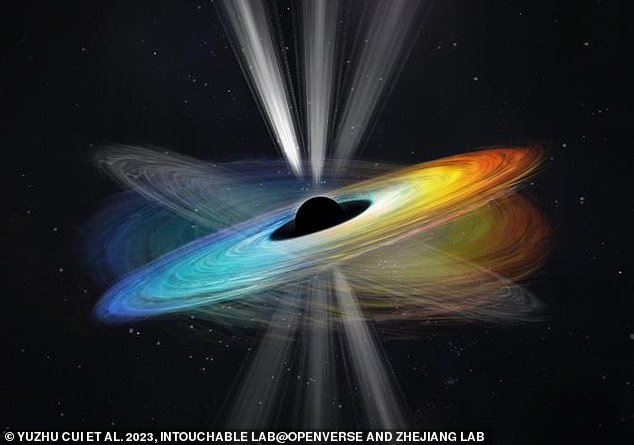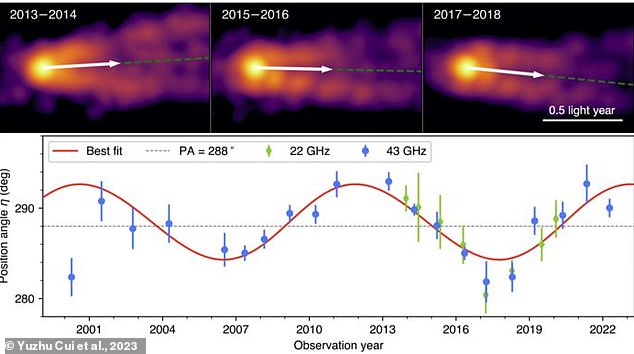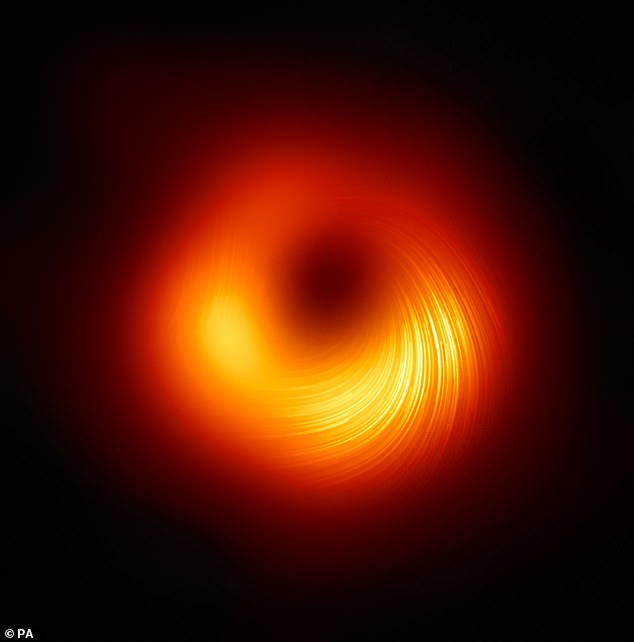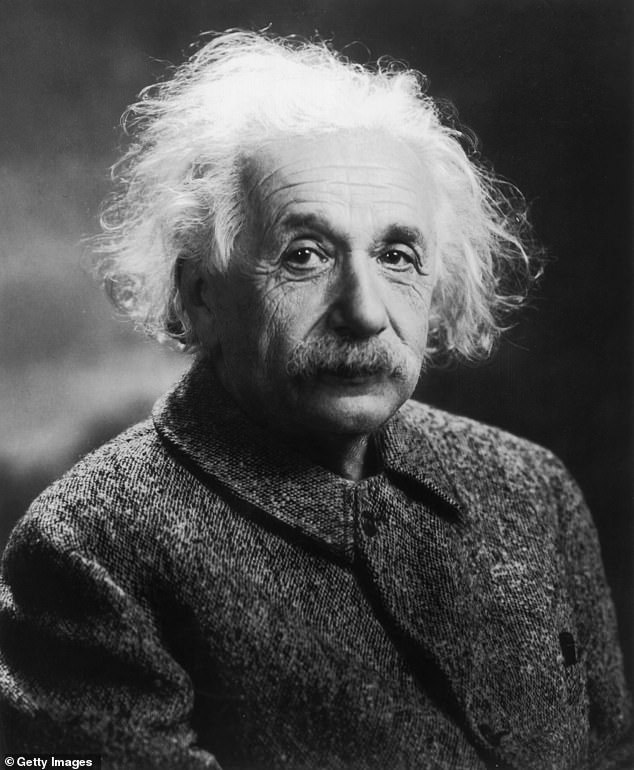Right again, Einstein! Scientists prove that ‘monster’ black hole M87 is SPINNING – in breakthrough that could help to unravel the mystery of the universe’s most enigmatic objects
For the first time, astronomers have found direct evidence that a black hole is spinning.
The discovery was made by studying powerful beams of energy emitted from the first black hole ever imaged by humanity, located at the heart of the neighboring Messier 87 star system.
Scientists have long believed that a black hole’s rotation powers these jets, but only now has this theory been proven.
It’s an ‘exciting’ breakthrough that strengthens Einstein’s theory of relativity and could help unravel the mystery of the universe’s most enigmatic objects.
M87 is a radio galaxy located 55 million light-years from Earth and has a supermassive black hole 6.5 billion times more massive than the Sun at its center.
Discovery: Astronomers have found direct evidence for the first time that a black hole is spinning

Spinning: The discovery was made by studying powerful beams of energy emitted from the first black hole ever imaged by humanity, located at the heart of the neighboring Messier 87 star system. The research found that one of these jets wobbled around a central point on the edge of the black hole, the experts said, much like a spinning top (shown)
This was captured by the Event Horizon Telescope (EHT) four years ago and described as a fluffy orange ‘doughnut’, but was renamed a ‘skinny ring’ when the image was enhanced by artificial intelligence.
“After the success of imaging black holes in this galaxy with the EHT, the question of whether this black hole is spinning or not is a central concern among scientists,” said Dr. Kazuhiro Hada of the National Astronomical Observatory of Japan and co-author of the book new study.
‘Now the expectation has turned into certainty. This monstrous black hole is indeed spinning.’
Black holes have such a powerful gravity that nothing can escape their clutches, not even light.
However, that doesn’t mean they can’t be seen.
That’s because they are surrounded by an accretion disk of gas and dust swirling right at the edge of the black hole’s event horizon.
Some of this material – which is stripped of gas clouds and stars – is swallowed up by the black hole, but a small amount is also emitted at more than 99.99 percent of the speed of light.
Scientists had previously predicted that the black hole’s spin could be the cause of this astrophysical jet, which was first observed in 1918.
They theorized that charged particles in the accretion disk produced a strong magnetic field that was then whipped up by the spinning black hole in such a way that the particles were thrown out as beams of energy.
Using data from a global network of radio telescopes spanning the period 2000-2022, researchers have now revealed that the jet appears to swing like a pendulum on an eleven-year cycle.
It appeared to wobble around a central point on the edge of the black hole, the experts said, like a spinning top.
“Detecting this precession provides unequivocal evidence that the supermassive black hole in M87 is indeed spinning, expanding our understanding of the nature of supermassive black holes,” the authors said.

Analysis: Using data from a global network of radio telescopes spanning the period 2000-2022, experts have revealed that the jet appears to swing like a pendulum in an eleven-year cycle

Stunning: The supermassive black hole M87 was captured four years ago by the Event Horizon Telescope (EHT) and described as a fluffy orange ‘doughnut’ (pictured), but was renamed a ‘skinny ring’ when the image was enhanced by artificial intelligence

Right again! The results are not only consistent with theoretical supercomputer simulations, but also fit Einstein’s theoretical predictions in his general theory of relativity.
Lead author Cui Yuzhu, an astronomer at the Zhejiang Lab in Hangzhou, China, added: ‘We are very pleased with this important finding.
‘Since the misalignment between the black hole and the disk is relatively small and the precession period (wobble) is about eleven years, collecting high-resolution data on the structure of M87 over a period of twenty years and in-depth analysis are essential to achieve this feat.”
The results are not only consistent with theoretical supercomputer simulations, but also fit Einstein’s theoretical predictions in his general theory of relativity.
Researchers hope their discovery can shed light on how black holes form and then evolve into the behemoths we see today.
The research has been published in the journal Nature.

